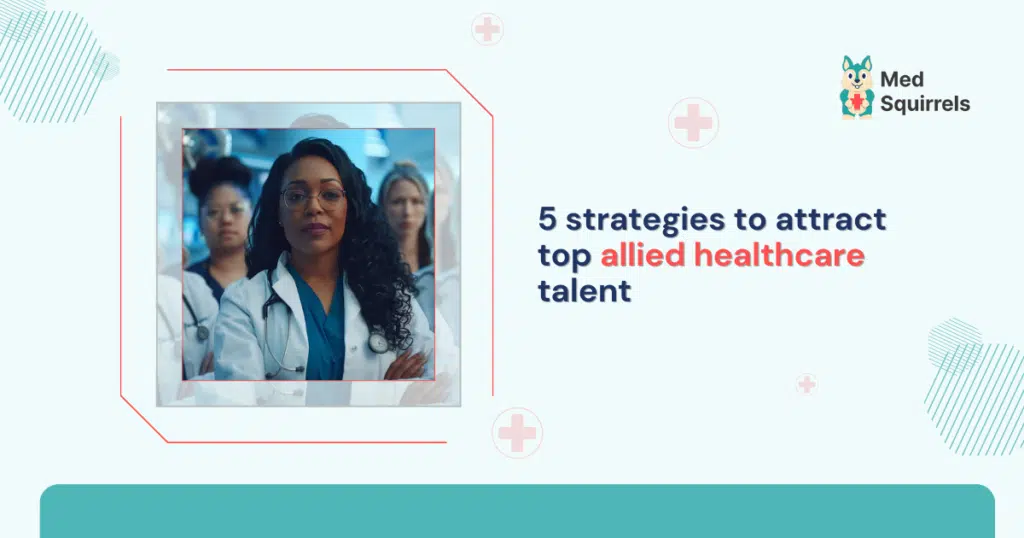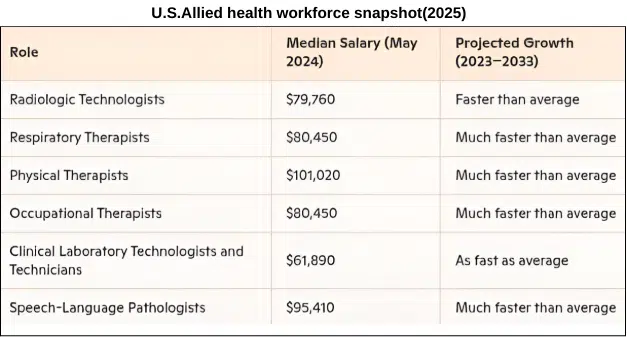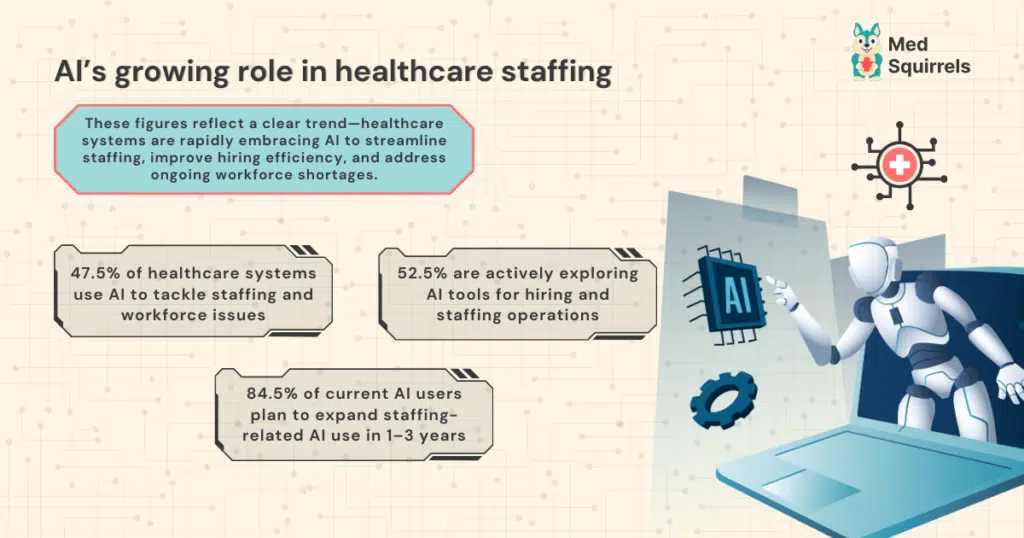5 strategies to attract top allied healthcare talent

Healthcare facilities are coming under pressure to staff crucial positions other than doctors and nurses. Allied health staffing is now a vital necessity as radiographers, respiratory therapists, and physical therapists are indispensable to the provision of well-rounded, efficient patient care. As competition increases and demand tightens, facilities need to reconsider how they attract and retain qualified professionals. Hoping that traditional healthcare recruitment strategies would work anymore is not a suitable option for an industry with talent that now has choices and aspirations
This blog will outline five innovative, smart strategies to attract top allied healthcare professionals that will be able to distinguish you from competitors, to overcome the allied health staffing shortage issue, and create an elite allied health workforce. Not adapting to modern platforms could lead to extended hiring cycles, decreased care quality, and increased burnout among current staff. Investing in the appropriate allied health workforce solutions today can set your facility up for long-term staffing stability and patient satisfaction. This growing urgency is reflected in the projected healthcare workforce shortages and rapid pay increases, as shown in the table below, sourced from the BLS.

#1 Offer competitive compensation and benefits
To attract and retain top-tier allied healthcare professionals, offering competitive compensation is essential. In recent years, wages in these roles have become more aligned with industry standards, reflecting the rising demand for skilled allied health talent. For instance, according to the U.S. Bureau of Labor Statistics, the median annual wage for diagnostic medical sonographers increased from $89,340 in May 2023 to$82,570 in 2024 an approximate 2.1% growth.
While this indicates positive wage progression, a significant pay gap remains when compared to physicians and surgeons, whose median annual earnings are among the highest in all occupations at $239,200 or more. In contrast, allied health professionals such as medical and health services managers earn a median salary of $117,960per year. This results in an average percentage difference of approximately 67.9% between the two median salaries, underscoring a substantial disparity in earning potential across healthcare roles.
In addition to competitive salaries, offering a comprehensive benefits package can enhance employee satisfaction and retention. Top employee benefits in 2025 include health insurance, retirement savings plans, generous paid leave, and monetary incentives. Other benefits like sign-on bonuses, relocation assistance, and student loan repayment programs can make your offer more attractive.
#2 Encourage a positive work culture
Fostering a positive work culture is essential for attracting and retaining allied health professionals in the U.S. These professionals seek environments where they feel valued, supported, and empowered.
Research indicates that factors such as recognition, leadership quality, and opportunities for advancement significantly influence job satisfaction and retention among allied health staff.
For instance, a study published in the Journal of Occupational and Environmental Medicine found that a strong workplace culture of health is associated with higher employee engagement and lower levels of stress and depression. Specifically, employees in organizations with a robust culture of health reported significantly higher engagement scores and reduced stress levels compared to those in organizations lacking such a culture.
Implementing recognition programs, team-building activities, and promoting a respectful leadership style can enhance long-term retention. Additionally, fostering work-life balance further boosts morale and participation among staff.
#3 Offer opportunities for professional development and prioritize work-life balance
Career advancement is one of the main drivers of professional choices for allied healthcare professionals. Hospitals that provide continuing education, higher-level certifications, such as Advanced Cardiac Life Support (ACLS) or Certified Medical Laboratory Technician (CMLT), and leadership training, like clinical leadership workshops or healthcare management programs, set themselves apart in the minds of ambitious professionals. Work-life balance is just as vital, particularly in high-stress health environments. Flexible scheduling, mental health care, and family-friendly policies assist in reducing burnout and keeping a healthy team intact. These practices breed loyalty while drawing prospects looking for long-term career advancement.
#4 Utilize technology and new tools for recruitment
Technology is transforming the way healthcare facilities approach allied health recruitment. Leveraging specialized job boards, social media, and healthcare-specific platforms broadens your reach and enhances targeting. AI-powered recruitment platforms and applicant tracking systems simplify hiring processes and minimize administrative effort. Emphasizing your facility’s adoption of digital tools also attracts younger, tech-savvy candidates who appreciate innovation. A technology-forward strategy reflects operational efficiency and forward-thinking leadership. This shift toward smarter hiring is further illustrated in the infographic below.

#5 Prioritize recruiting candidates open to transition
One underutilized strategy to attract top allied healthcare professionals is targeting those willing to make the switch between specialties or between care settings. These individuals usually have varied experiences and new ways of thinking that enhance your care provision. Through cross-training sessions or bridge programs, healthcare centers can reskill interested professionals and solve healthcare workforce shortages. This is not only a way to broaden the recruitment base but also helps in internal mobility and professional satisfaction. Facilities looking to hire allied healthcare professionals from diverse clinical backgrounds will benefit from this adaptable approach.
Example: A radiologic technologist who wishes to become a sonographer may be more encouraged to apply for a facility with in-house training and certification assistance.
The pitfalls of traditional staffing partnerships — and the MedSquirrels solution
Although numerous healthcare facilities continue to use traditional staffing agencies to recruit allied health roles, these partnerships usually carry drawbacks. One primary drawback is that there is no customization—traditional agencies have predictable routines that do not quite fit your unique staffing requirements. This leads to misaligned placements, lagging onboarding, and increased administrative burdens, all of which exacerbate healthcare workforce shortages. Another area of concern is the use of outdated recruitment processes by many traditional agencies. With a lack of tech adoption, they are struggling to reach top-quality candidates or optimize job placements. Such inefficiency does not just delay hiring, it also increases costs and turnover. Read more on how flexible staffing models improve hiring outcomes.
Example: A hospital or a healthcare facility working with a traditional staffing agency may take weeks to fill a physical therapist position, losing business and stressing existing staff in the interim.
MedSquirrels addresses these issues using a new, modern, AI-driven platform designed exclusively for healthcare staffing. Whether you need to scale up fast or replace hard-to-fill positions, MedSquirrels provides affordable allied health workforce solutions that outperform traditional approaches.
MedSquirrels caters to you with three useful and affordable plans. The Orange Plan offers full-service staffing with end-to-end support, such as sourcing, onboarding, payroll, and liability protection—best for facilities in need of total administrative relief.
The Purple Plan is most suitable for hospitals that have a preferred candidate but need help with credentialing, HR compliance, and onboarding. This plan enables you to be in control while lessening your burden of operation. Lastly, the Blue Plan is tailor-made for the tricky-to-fill positions. It provides highly focused recruitment by taking advantage of AI technology to entice the best allied healthcare professionals more effectively.
The platform also offers real-time hiring transparency, ensuring you can test its efficiency without long-term risk. With its pay-per-hire model and flat-rate options, MedSquirrels keeps staffing costs affordable and aligned with your budget.
By making the move to partner with MedSquirrels, healthcare facilities have a strategic partner that knows the special challenges of allied health staffing and offers the solutions and flexibility to overcome them.
Allied health staffing will continue to shape how care is delivered across disciplines. Understanding these key strategies and adapting your approach is the best way forward for those aiming to succeed amid rising demand and tighter talent pools. For forward-thinking healthcare providers, MedSquirrels offers the best-fit allied health staffing model for the modern era. You can book a free demo to see our staffing platform in action!
FAQs
How can healthcare facilities attract top allied health talent?
Healthcare facilities can attract top allied health talent by offering competitive compensation, professional development opportunities, fostering a positive work culture, and implementing modern recruitment strategies. Providing work-life balance and flexible scheduling also helps.
What types of allied health professionals are in demand?
Some of the most in-demand allied health professionals include physical therapists, radiographers, respiratory therapists, occupational therapists, speech-language pathologists, and medical laboratory technicians. The demand varies depending on the specialty and geographic location.
What qualifications are required to become an allied health professional?
The qualifications vary by profession but typically include relevant education (degree, diploma, or certification), clinical training, and licensure or certification from an accredited regulatory body. Some roles may also require specific experience or specialization.
How does MedSquirrels differ from traditional staffing agencies?
Unlike traditional staffing agencies, MedSquirrels uses advanced AI technology to automate recruitment, match candidates to job openings faster, and provide tailored solutions. MedSquirrels is more transparent, flexible, and efficient, offering modern workforce solutions that meet the unique needs of healthcare facilities.
What makes MedSquirrels a strategic partner for healthcare staffing?
MedSquirrels is a strategic partner because it understands the unique challenges of allied health staffing and provides a tech-forward, flexible, and cost-effective approach to meet healthcare facilities’ staffing needs. The AI-driven platform ensures quicker, more efficient placements, reducing strain on administrative resources.
